Blues Reviews June/July 2016
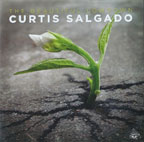 Curtis
Salgado
Curtis
Salgado
The Beautiful Lowdown
Alligator 2016
Former front man for the Robert Cray Band, Santana, the Steve Miller Band,
and Roomful of Blues - is that a resume, or what?? - Curtis Salgado follows
up his 2012 Alligator release “Soul Shot” with another album
of a dozen fine songs. He is supported by producer Tony Braunagel, the
core of The Phantom Blues Band, and an array of outstanding ancillary
musicians.
Let’s begin with the obvious: Salgado continues to reign at the
highest echelon of living soul and R&B singers. Capable of crooning,
shouting, rasping, moaning, cajoling, and testifying, at age sixty-two
he retains every ounce of his amazing voice. The man can bring tears to
my eyes one moment, and make me swell with joy and optimism the next.
Such innate talent is a gift that requires nurturing and preservation
on the artist’s part, and merits appreciation on the part of us,
the listeners.
On this outing, all but one of the tunes has been composed by Salgado
in cooperation with his colleagues. Throughout, he enjoys the impeccable
support of Braunagel on drums, Mike Finnigan on organ, Larry Fulcher on
bass, and Johnny Lee Schell, the basis of Phantom, plus multiple other
luminaries too numerous to name, but including pianist Jim Pugh, guitarists
Vyasa Dodson and Terry Robb, and a talented ensemble of horn players and
background singers. Finnigan and Pugh, on their respective keyboards,
deserve special recognition not only for their individual contributions,
but also for several tracks in which their playing meshes deliciously.
Schell is in top form as well. (Salgado, a proficient harmonica player,
only picks up his harp on three numbers.)
The guts and glory of the album, appropriately and unsurprisingly, is
Curtis’s singing. Yeah! He cruises through these songs like a knife
through butter, nailing the vocals consistently and impressively. The
prevailing theme is R&B; there is no straight twelve-bar blues song,
but it’s all bluesy. For a little variety, there’s a devotional
number, “Healing Love,” distinguished by Terry Robb on acoustic
guitar, and even a reggae tune, “Simple Enough,” abetted by
the horn section. Those two tracks make my album highlight list, along
with “Walk a Mile in My Blues.” Another track, “Nothing
in Particular” has a jazzy flavor, enhanced by Chris Hayes on lead
guitar, and the only cover song, a Johnny Guitar Watson tune, “Hook
Me Up,” evokes comparison with The Crusaders or War.
For me, the culmination is “Is There Something I Should Know,”
a duet with Danielle Schnebelen, another singer with a divine voice, and
backed by another terrific Finnigan organ contribution.
If you love great singing and great soul music, this album is an absolute
winner.—Steve Daniels
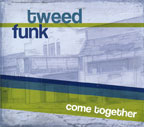 Tweed
Funk
Tweed
Funk
Come Together
Tweed Tone Records
www.tweedfunk.com
With the proliferation of new soul and neo soul bands Tweed Funk is a
welcome relief from these pretenders because the Funk is the real thing.
Singer Joe “Smokey” Holman recorded for Motown, Stax and numerous
smaller labels before seeking the security of a day job to raise his family
in Milwaukee. Smokey’s return to the stage with this crack band
has brought us a fully formed soul monster. With their second CD “Come
Together” they’ve upped the ante putting more emphasis on
the horn section for a brand new classic soul sound. The core band of
Smokey, Eric Manic - bass and JD Opteker - guitar have added new members
Dave Schoepke - drums, Andrew Spadafora - tenor and baritone sax with
Doug Woolerton of Roomful Of Blues on trumpet. Their sound, a cross between
Motown and Stax is befitting their Mid-Western soul roots.
The bass slinks in like Jamerson with a Coffey styled guitar riff similar
to “Ball Of Confusion” as the horns urge Smokey to “Light
Up The Night” then bassist Madnic doubles down on Hammond organ
and the backing vocals of Chrissy Dzioba and Sara Moilanen lightens the
mood on the Curtis Mayfield-like anthem “Don’t Give Up.”
The “Muse” is a tribute to all the ladies that have inspired
musicians but the driving “Love Ain’t Easy” with bassist
Eric Madnic tripling down with guitar and backing vocals gives a different
look at some of the ladies at the shows. Smokey Holman relates the true
tale of how “Sweet Music” saved his soul allowing him to cut
though the jungle and inspire others to “Come Together.” Slowing
to the gentle sway of “Embrace” bassist Eric Madnic doubles
on Fender Rhodes piano as the female vocals lean close and whisper in
your ear then a muted trumpet cuts through “Bullet” like the
poof of a silencer. The horns take the lead on the instrumental “Who
Is This” then the rhythm section with JD’s guitar chugging
to a classic groove as Smokey get’s his “Soul Rockin”
as the horns go all out for the finale.
Tweed Funk’s new CD has really “Come Together,” they’ve
become saviors of soul getting back to a classic sound and making it the
future of funk.—Roger & Margaret White
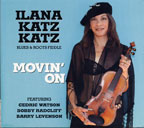 Ilana
Katz Katz
Ilana
Katz Katz
Movin’ On
www.ilanakatz.com
In a market full of singer/songwriters there’s an abundance of vocalists
with pleasant, pitch perfect voices. So hearing someone outside the expected
norm some might dismiss that singer without getting what’s really
going on. Ilana Katz Katz’s unique vocals harmonize with her fiddle
giving her music its hauntingly soulful tone. For her newest CD “Moving
On” she performs solo, as a duo, trio and quartet - each line up
presenting a mix of traditional tunes with reworked lyrics befitting Katz’s
feminine perspective, classic covers and originals. Miss Katz works with
several different producer/engineers/ accompanists including Cedric Watson
- gourd banjo, washboard, bass and vocals, Barry Levenson – guitar
and Daniel Sandburg – drums, creating a disc with a charm reminiscent
of a bygone era.
Before “Movin’ On” you have to get back to the roots
with Big Joe’s classic “Baby Please Don’t Go”
backed by Watson’s banjo and washboard with hand drums by Danial
Sanda and a wailing fiddle. This line up rolls into a haunting tale of
“Reubin’s Train” with a steady rhythm that then slips
into a reworking of “Greasy Coat” to “Greasy Cool”
about the sad predicament of some women and last with this line up is
a banjo under high flying fiddle on the ethereal original “Forevermore.”
Starting out slow then kicking into high gear for a fiddle and banjo duel,
Cedric takes on the vocals for “Lazy John/Sail Away Ladies.”
In a swinging instrumental tribute “Blues For Bobby Radcliff”
Cedric takes over on lead fiddle and joining this trio is Chas Jastus
on guitar. Bobby Radcliff himself brings his guitar for the first song
he and Ilana played at Terra Blues, “Tanya,” a Joe Liggins
and the Honeydrippers number skillfully reworked for fiddle and guitar,
sounding reminiscent of “Happy Trails,” with Goeff Wright
on bass and Dave Moore drums. This combo rocks thing up as they rip into
“Kansas City” with Katz altering the lyrics to make it her
own, then two of Katz’s originals: a slinky slow burner called “Demon
Blues” and a bouncy fiddle-fed shuffle with Katz scatting the “Cruel
Willie Blues.” Barry Levenson’s jazzy guitar teams up with
Katz, Hank Van Sickle on bass and Mike Sandberg on drums for their swingin’
cover of Big Bill Broonzy’s “Sweet To Mama” and Katz
chills to the bone with “You Crush My Soul.” To close out
this disc Katz goes solo, just vocal and fiddle with a traditional cover
of “Jack Of Diamonds.”
Ilana Katz Katz isn’t your typical girl singer and doesn’t
want to be, she’s laying it down her way and “Movin’
On.”—Roger & Margaret White
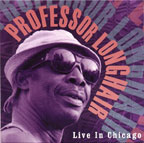 Professor
Longhair
Professor
Longhair
Live In Chicago
Orleans Records
www.orleansrecords.com
Henry Roeland ‘Roy’ Byrd, better known to the world as Professor
Longhair, is a man as complex as the rhythm & rumba he played, a tap
dancer, card shark, icon of piano and New Orleans legend. He first recorded
in 1948 and his only national hit was “Bald Head” in 1950
but his style of rhythm and blues was there from the start with “Tipitina”
and “Mardi Gras In New Orleans” complete with whistling intro.
With his rockin’-rumba piano style and yodeling vocals he wasn’t
thought of as a hit maker by the powers that be and his biggest early
success was as writer with “Rockin’ Robin” (tweedly
dee). By the mid ‘60’s he’d given up music, making a
living dealing cards and sweeping the floors of record stores. His resurrection
came in 1971 playing the second New Orleans Jazz & Heritage Festival
and he remained its patron saint closing the show every year until his
death in 1980. He had close to a decade of European tours, albums, TV
shows and a documentary. But the majority of his catalog was released
after his death so finding this recording, “Live In Chicago”
after forty years is a rare treat and special look at the man in his heyday.
Supported by his own band featuring Billy Gregory on lead guitar, Will
Harvey on rhythm guitar, Julius Farmer on bass and drummer Earl Gordon
at the 1976 University Of Chicago Folk Festival. This was originally broadcast
live on WFMT-FM, the quality of the recording is excellent with the acoustic
piano up front and strong.
After a humble intro Longhair literally leaps from the speakers with the
instrumental “Doin’ It” as the drums churn in the back
and Fess calls out “Billy” for a solo and the more traditional
“Everyday I Have The Blues” with Billy stepping to the fore
between verses. Taking a gentle, almost scholarly introduction to “Big
Chief” where even the wrong notes sound just right. Not wasting
a moment Fess charges straight into “Mess Around” and “Mardi
Gras In New Orleans” then takes an extended work out with “Got
My Mojo Working” and the crowd goes wild as they roll into an encore
as Gregory’s guitar is featured on “Fess’ Boogie.”
“Live In Chicago” is a rare snapshot in time, as Roy Byrd
basks in his renewed renown after a decade of neglect with this rhythmic
romp as Professor Longhair.—Roger & Margaret White
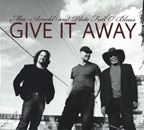 Mac
Arnold and Plate Full O’ Blues
Mac
Arnold and Plate Full O’ Blues
Give It Away
Plantation #1 Productions 2015
It’s our good fortune that Mac Arnold returned to the blues about
a decade ago after a stint as an organic farmer. Over the last 50 years,
since his teens, Arnold has played, mainly as bassist, with a pantheon
of blues and R&B greats, including James Brown, Muddy Waters, John
Lee Hooker, Otis Spann, Otis Redding, and saxophonist A.C. Reed. He has
also collaborated in the recording studio with Quincy Jones and helped
produce the television show “Soul Train.”
That impressive resume has provided him the experience behind this new
album, his first since 2011. Backed by his long-time “Plate”
bandmates Austin Brashier and Max Hightower, with the addition of drummer
and co-producer Scotty Hawkins, the ensemble delivers a baker’s
dozen of classy tunes, all but two of them originals.
Front and center throughout are Arnold’s vocals, the limited range
of which is more than compensated by grit and poignancy. Arnold plays
a mean bass as well, sharing those duties with Hightower, who otherwise
shines on keyboard and harmonica. Brashier concentrates on guitar, but
Arnold lays down some fine guitar licks as well, utilizing his home-made
gas can guitars - whose construction was taught to him by his brother
Leroy, who made the first one for four-year-old Mac in 1946.
The album opens with “Nickel and Dime,” Arnold’s tale
of the travails of a bluesman on the road. The ensuing “Don’t
Burn My Cornbread” can be interpreted as an ode to food, or a sexual
double entendre; either way, it’s a mid-tempo groove with droll
wit. “Uncle DeWitt’s Café” is a reminiscence
of youthful times at a juke joint, followed by the Chicago blues-like
“Damned If I Do,” with Hightower blowing some tuneful harmonica.
The album really hits high gear with the next three numbers. “Give
It Away,” an inspirational gospel number, is succeeded by the R&B
“Fool Hearted Lover,” Hightower providing tasteful organ accompaniment
and Brashier a beautiful guitar solo. The band then digs into “Nitty
Gritty,” a rocker extolling the value of the blues.
The remainder of the tunes are eclectic, ranging from poignant love ballads
to a jocular Jerry Reed cover, “Amos Moses,” to the closing
country-flavored “Memories,” a tribute to the late Leroy Arnold,
with moving harmonica and acoustic guitar accentuating Brashier’s
smooth vocal. Equally worthy of mention is the band’s cover of Brook
Benton’s “I’ll Take Care of You,” with Arnold’s
best vocal on the disc.
Arnold may be in his mid-70s, but he still sounds damn good. —Steve
Daniels

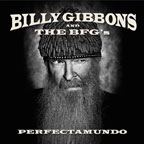 The Animals
The Animals
Animal Tracks
ABKCO Records EP www.abkco.com
Billy Gibbons & The Bfg’s
Perfectamundo
Concord LPconcordmusicgroup.
Here’s a couple of recent vinyl releases that might be a little
hard to find—but are definitely worth the search. The Animals were
probably the most accomplished stylists among the galaxy of British R&B
bands to emerge out of London’s suburbs in the mid-60s. Their raw,
hard-driving sound—that showcased Eric Burdon’s “black”
vocals in tandem with Alan Price’s pumping organ—quickly attracted
an ardent following and with record companies seeking R&B groups in
the wake of the Rolling Stones’ Top Ten singles success with their
version of Lennon/McCartney’s “I Wanna Be Your Man,”
Burdon and crew were quickly signed by EMI’s Columbia label. They
were initially produced by the ill-fated, legendary Mickie Most and eventually
released five 7-inch extended-play records that were, at the time, solely
available in the UK and select European markets. This marvelous Record
Store Day release is the set’s Stateside debut and the first-ever
as a ten-incher. Animal-ized renditions of Chuck Berry’s “How
You’ve Changed,” Ray Charles’ “Believe To My Soul,”
Shirley & Lee’s “Let The Good Times Roll” and Big
Maceo Merriweather’s “Worried Life Blues” are quite
compelling and, along with their dynamic reworking of “House Of
The Rising Sun,” were one of the main inspirations for Bob Dylan
going “electric” and linking up with Ronnie Hawkins’
rip-roaring back up combo, the Hawks, who quickly morphed into the Band.
A long time coming, Perfectamundo is the debut solo project for ZZ Top
guitarist/vocalist Billy Gibbons and exudes an Afro-Cuban sound and feeling
that may come as a surprise to ZZ Top’s world-wide fans and followers.
Actually, Gibbons studied Latin percussion (conga, bongo, maracas and,
most importantly, timbales) in Manhattan with none other but the “Mambo
King” himself, Tito Puente, years before he formed the psychedelic
rock trio back in Houston. The concept for Perfectamundo, co- produced
by Gibbons and Joe Hardy and subsequently recorded in Houston, Los Angeles,
Austin and Pontevedra, Spain, was Gibbons’ invitation to perform
at the 2014 Havana Jazz Festival by his Argentine-born and Puerto-Rican
raised musical collaborator Martin Guigui. Gibbons had to decline Guigui’s
offer but began exploring the concept of an Afro-Cuban flavored album
in his Houston studio. Highlights begin with delightfully Latinized covers
of blues contemplations like “Baby Please Don’t Go”
and “Pickin’ Up Chicks On Dowling Street,” a haunting
“Hombre Sin Nombre,” a slow-boiling reworking of Roy Head’s
immortal “Treat Her Right” and the smoking instrumental closer
“Q-Vo”—with even some artfully subdued hip-hop sub-tones
in evidence on both the title track and “You’re What’s
Happenin’, Baby.” A note on the back cover puts it this way:
“A serious, way-out expression of Gibbon-ized, cross-cut blues stylings
inspired from 90 miles across the Strait of Florida.” I agree—solid,
sizzling and soulfully satisfying.—Gary von Tersch
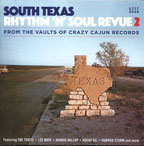 Various
Artists
Various
Artists
South Texas Rhythm ‘N’ Soul Revue 2
Kent CDKEND 441www.acerecords.com
As Tony Rounce puts it at the outset of his image-laden (great label shots)
liners: “Opened in 1926, Route 90 occupies over 1600 miles that
stretch from east to west across the lower American south—from Jacksonville,
Florida to Van Horn Texas. It’s something of a Southern equivalent
to the more famous Route 66 and like 66 has been celebrated in song by
bluesman Clarence Garlow, onetime resident of Lake Charles, Louisiana,
one of 90’s many stop-off points.” It’s also a notable
highway as far as music is concerned, especially the segment that goes
through South Texas and cities like San Antonio, Houston and Beaumont,
that not only boasted a wealth of talent but was the home of some of the
state’s most important record labels and producers. No more so than
the Houston-based, big-eared “Crazy Cajun” Huey Purvis Meaux,
whose multifarious productions and many record labels pioneered what is
now referenced as the “Highway 90 Sound”—a dance floor-filling
blend of soul and R&B atop a bedrock of blues. Some of the artists
featured on this 24 track collection are not Texans but all came from
towns crisscrossed by Highway 90, which was the quickest way to get them
from one gig to the next—with the occasional stop in the Houston
area to cut a few tracks in hopes of following rivals like Barbara Lynn,
Freddie Fender, the Sir Douglas Quintet (Meaux’s answer to the “English
Invasion” of the mid-sixties) and Roy “Treat Her Right”
Head into the Top 40 or Hot 100. A few of the musicians here did manage
some national notice (Ronnie Milsap, Jean Knight, Johnny Adams, Warren
Storm and Joe “Guitar Hughes) but for the majority the airplay only
served to, hopefully, engender attendance at their live appearances. Favorites
are many (like I said, my old buddy Meaux had great “ears”)
including a pair by Jackie Payne (“At Your Wedding” and “Skid
Row Blues”), professional baseball player Arthur Lee Maye’s
“Total Disaster,” songwriter Joe Medwick’s “After
Hour Man” and a great version of Meaux’s own “Neighbor,
Neighbor” by Margo White. An excellent follow-up to Volume One!
More please.—Gary von Tersch
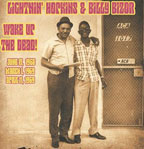
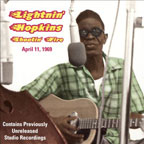
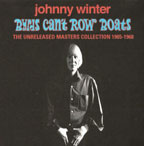
Lightnin’ Hopkins & Billy Bizor
Wake Up The Dead!
Cicadelic CICD-6869 (2 CD) www.cicadelic.com
Lightnin’ Hopkins
Shootin’ Fire
Cicadelic CICD-41169
www.cicadelic.com
Johnny Winter
Birds Can’t Row Boats: Unreleased Masters 1965-1968
Cicadelic CICD 6568 (2 CD) www.cicadelic.com
Five full CDs worth of great sounding Texas blues vibrations from three
of the Lone Star state’s greatest blues masters. While harmonica
ace Billy Bizor is relatively obscure compared to both Hopkins and Winter,
he was the endlessly inventive folk-poet Lightnin’ Hopkins’
virtuosic chromatic foil on many of Lightnin’s late 1960s recordings
(along with, occasionally, George “Wild Child” Butler) that,
characteristically, mixed slow, observational and often autobiographical
numbers with his patented out-and-out boogies. The clever title of the
two-disc set references San Francisco’s Grateful Dead, whose live
repertoire included such Hopkins classics as “Katie Mae,”
“See That My Grave Is Kept Clean” and “Ain’t It
Crazy”—the Jefferson Airplane’s lead guitarist Jorma
Kaukonon, likewise, often indulged himself with psychedelic variations
on Lightnin’s “Black Mare Trot” and “Come Back
Baby.” Disc one compiles every track Lightnin’ and his cousin,
the ill-fated Billy Bizor recorded for Roy Ames’ Clarity Records
on June 17, 1968 (highlights include the title song, “Vietnam War,”
“Pine Gum Boogie,” “Next Trip Down South” and
“Walking Blues”) along with some previously unreleased outtakes
from an April 11, 1969 date that were omitted for lack of space on the
also-just-released Shootin’ Fire CD—the band really gels on
“Feel Like Ballin’ The Jack” and fully nine minutes
of his early hit “Mojo Hand.” The second disc on Wake The
Dead features all of cousin Bizor’s solo recordings in 1969 for
a proposed album that never saw the light of day with his unexpected death
on April 4, 1969—the first seven tracks are stunningly superb demos
(favorites include “Whiskey Head Woman,” “T Model Ford”
and the oddly prescient “When I’m Dead”) while the remainder
finds Bizor backed by a full band and obviously enjoying himself full-speed-ahead—head-turners
begin with “I’ll Miss You So” and “Let’s
Pitch One.” The prolific Hopkins, additionally, recorded over a
dozen titles for Clarity on the fore-mentioned April 11, 1969 session
(the overflow is on Wake The Dead, see above) with an abundance of new
originals (“Born In The Bottom,” “December 7, 1941,”
“Rainy Day In Houston” and the humorous “Stinking Foot”)
engagingly balanced by oldies revisions on the order of “Shinin’
Moon,” “Shake That Thing” as well as, on a more serious
note, “My Baby Ain’t Got No Shoes,” “Old House
Torn Down” and “My Baby Was Crying For Bread.” Two tracks
from August, 1961 (“Good As Old Time Religion” and “I’m
Shootin’ Fire”) close affairs and give this project its very
apt title and what makes this release doubly rewarding is that, for the
first time, the blatant over-mixing of the bass and drums and reverb over-use
that occurred when some of this material was originally released—in
order for Hopkins to sound more contemporary—has been wonderfully
corrected. Beaumont, Texas born Johnny Winter was quite prolific
as well and is best known for his smoking blues-rock albums for Columbia
Records and phenomenal live shows in the late 1960s and throughout the
1970s. In addition to recording several Grammy-nominated blues projects
Winter also produced three Grammy-winning albums by the legendary Muddy
Waters. This two-disc extravaganza collects, for the first time, all the
consistently inventive attempts at a “hit” (1965-1968) made
by Winter right before Columbia came calling with half-a-million dollars—widely
hailed “discovery” Winter had actually first recorded in 1959
as a teenager! The sound that he was experimenting with in the mid-sixties
varied from Byrds and Bob Dylan influenced folk-rock (“The World
Turns All Around Her,” “Avocado Green,” “Parchman
Farm,” “Ballad Of Bertha Glutz”) to psychedelic-fringed
numbers like “Birds Can’t Row Boats,” “Take A
Chance On My Love,” “Livin’ In The Blues” and
the two-parter “Comin’ Up Fast” to hard-rock (“Hook
You” and “Rock Me”) but, most of all, the blues. As
producer Roy Ames puts it: “The blues came naturally to Johnny,
from years of listening to Beaumont black radio station KJET and playing
old blues 78s.” Particular picks include “Pneumonia Blues,”
“32-20 Blues,” “Goin’ Down Slow” and “Don’t
Drink Whiskey.” Twenty of the 36 tracks have never been released
before. All are sourced from the original four track half-inch masters
and first generation mix-down tapes. As an added bonus a 16-page booklet
is full of rare and never before seen Winter memorabilia. Enjoy!—Gary
von Tersch
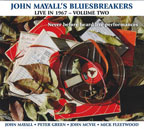 John
Mayall’s Bluesbreakers
John
Mayall’s Bluesbreakers
Live in 1967 - Volume Two
Forty Below Records 2016
It’s not as if John Mayall needs to release more albums. Inducted
into the Blues Foundation’s Hall of Fame in February of this year,
Mayall at age 82 continues to tour. Under his own name or with his band
of revolving principals, the Bluesbreakers, as of this release he has
reached sixty-four albums in his discography! Perhaps only John Lee Hooker,
Lightnin’ Hopkins, and maybe B.B. King have released as many albums,
and many of those were compilations.
This one is a compilation, also; a follow-up to…you guessed it,
Volume One. Each features the same iteration of the Bluesbreakers: Mayall
on vocals, harmonica, and organ (no guitar, although he is a commendable
six-string purveyor), Peter Green on guitar, John McVie on bass, and Mick
Fleetwood on drums. Something sound familiar? Green and Fleetwood left
the Bluesbreakers at the end of 1967 to form their own band with bassist
Jeremy Spencer. McVie followed not long after, Danny Kirwen was added
on guitar, and famed 1970’s Fleetwood Mac was born.
The tracks on this and the preceding “Live…” album were
recorded at various venues on a one-channel reel-to-reel tape recorder
by an avid fan, and have been restored. As is to be expected, the sound
quality is variable, and far less pristine than that of 21st century recordings.
Nonetheless, the thirteen cuts are of more than historical interest.
Particularly noteworthy are Mayall’s personalized renditions of
several blues classics. “Talk to Your Daughter,” penned by
J.B. Lenoir, was justly made famous by Magic Sam (Maghett) on his seminal
Chicago blues album, “West Side Soul,” released in the same
year, 1967, that this version was recorded. B.B. King’s “Sweet
Little Angel,” Otis Rush’s “Double Trouble,” and
T-Bone Walker’s “Stormy Monday” are likewise given Mayall’s
individualized twists . Most of the other songs are also covers; only
“Tears in My Eyes” and “Chicago Line” were composed
by Mayall.
Throughout, Mayall’s reedy vocals are augmented by his unique style
of harmonica playing; he often used the “Mississippi saxophone”
as a rhythmic percussion instrument rather than augmenting melody. Fleetwood
and McVie provide good support, although the bass is frequently lost in
the mix and Fleetwood’s drumming sometimes becomes rote. For me,
the highlight is Peter Green on guitar. Among the many guitar mavens who
have been in the Bluesbreakers, including Eric Clapton, Harvey Mandel,
Walter Trout, and Coco Montoya, many consider Green the best. Here he
delivers both scorching single note runs and meandering pensive leads
with equal deftness, making the CD a good value for his contributions
alone.— Steve Daniels
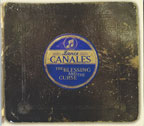 Lance
Canales
Lance
Canales
The Blessing and the Curse
Music Road Records 2015
It’s always a pleasure to discover a high quality artist with whom
one was previously unfamiliar. Thus, Lance Canales.
A product and denizen of Central California’s Central Valley, Canales
is a guitarist and singer whose proclivity tends toward folk and American
roots music, but with a decidedly bluesy intonation. This album of eleven
original tunes and two covers pairs him with a group of adept musical
colleagues, including producer, guitarist, and singer Jimmy LaFave, eminent
vocalist Eliza Gilkyson, and former International Blues Challenge solo
artist winner Ray Bonneville. The result is a rousing and moving album.
The focus of the set is Canales’ singing, which merits praise. His
raspy timbre is ideal for conveying both power and emotion. Interestingly,
in at least two of the tracks - “Hich-wyah Man” and “Old
Red” - his singing evokes comparison with Rob Thomas of the group
Matchbox 20, and both cuts spur comparison with Thomas’ successful
collaboration with Carlos Santana on the hit single “Smooth.”
A major difference is the lack of soaring single note guitar licks a la
Santana, but Canales’ gritty acoustic guitar stylings are themselves
compelling. Bonneville lends nice electric guitar to “Old Red”
and “Cold Dark Hole.”
Although no song hews to the standard twelve-bar classic blues format,
there is a blues ambience throughout. The lyrics of several songs, such
as “California or Bust” and “The Farmer,” draw
on Canales’ ambivalence about his region of origin, reflecting affection
for Central California along with recognition of its demanding agricultural
way of life.
Although all of Canales’ own songs are laudable, he shines particularly
on the two covers: Woody Guthrie’s “Deportee,” distinguished
not only by Lance’s vocal but also his juicy guitar playing; and
the Reverend Gary Davis classic, “Death Got No Mercy,” with
producer LaFave adding acoustic guitar and Gilkyson her smoky vocal in
duet with Canales’ baritone. I think that Davis would have enjoyed
it as much as I did.—Steve Daniels
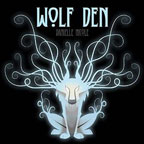 Danielle
Nicole
Danielle
Nicole
Wolf Den
Concord
Danielle Nicole’s first excursion outside of Trampled Under Foot
is a delight. Her palette ranges from mellow to rockin’, from torch
songs to torched octane crunchers. All but two are from her own prolific
pen. She serves up a superb version of I Feel Like Breaking Up Somebody’s
Home with Luther Dickerson on guitar, and Anders Osborne’s It Ain’t
You has Osborne rockin’ behind. Otherwise, all hers, mostly co-written
with Osborne. The opening title cut is a funky look at enticements and
a decidedly darkened path. No happy ending here. “You’re on
your own/been chewed to the bone/still, you can’t stop thinking/
when you get back down the road/you’ll be howlin’ for more/scratching
at the door.” How You Gonna Do Me Like That, driven by Mike “Shinetop”
Sedovic, the erstwhile organist with Trampled Under Foot, and the baddest
drummer in the land, Stanton Moore is a song about love sneaking up. She
sings, “I was blind to all of the signs/Now I find/you’re
on my mind all of the time.” Take It All is a breakup song with
a classic soul groove and Easin’ Into the Night is a slick finger
snapper about getting used to the single life. The speakers rock for You
Only Need Me When You’re Down. Osborne’s guitar is fiery and
fuzzy. Luther Dickerson takes the guitar chair on Waiting On Your Love
and that southern rock groove pops out underneath Danielle’s decidedly
Bonnie Raitt-ish medium tempo feel. Just Give Me Tonight is a tender heartbreak
of a ballad that builds in intensity. She sings with power and drips with
emotion. When she sings, “When I lay down at night/thinking about
you/I can’t help but wonder/if you want to hold me too,” my
first thought is “what’s wrong with that guy?” Didn’t
Do You No Good has an Oh Well bass line in the bridge, the drums are tribal
and Osborne is inventive and appropriately rocking. Danielle Nicole is
totally on fire here. Whew!! Funky, classic soul draped in the blues,
this is highly recommended.—Mark E. Gallo
 Golden
State Lone Star Blues Revue
Golden
State Lone Star Blues Revue
Electro-Fi
Great West Coast swinging blues by masters of the craft. Little Charlie
Baty and Anson Funderburgh on guitars, Mark Hummel on vocals and harp,
R.W. Grigsby on bass and Wes Starr on drums. Eric Spaulding and Jack Sanford
on saxes and Jim Pugh on piano and organ. Whew! Tunes from Gatemouth Brown,
Billy Boy Arnold, Lowell Fulson and Mose Allison comingle with originals
from Hummel. The results are as electric as you’d expect. Gatemouth’s
Midnight Hour opens the set and sets the pace. Guitars blazing and the
rhythm rocking. Classic. Hummel’s harp shines on Arnold’s
Here’s My Picture (“please leave it in your frame”)
with a tom-tom rhythm romping behind. The first of the Hummel originals,
Prove It To You (ain’t got a job/ain’t got a cent/I ain’t
got enough just to pay our rent/I’m gonna prove it to you baby/I’ve
got just what you need”) gives everyone room to shine. Baty’s
guitar is distinct on the first chorus, followed by hard blown harp. Fulson’s
Check Yourself has swinging saxes and rollicking piano to recommend it,
along with Anson Funderburgh’s guitar. The version of Mose Allison’s
Stop This World works surprising well. Again, Hummel’s harp is gorgeous.
. Lucky Kewpie Doll has both guitarists trading licks with an extended
piano solo in the middle. Pepper Mama is a tribute of sorts to BB King
that again features the guitarists. Jimmy McCracklin’s Take a Chance
has Jim Pugh on organ and reaches back to the band’s collective
influences. Golden State and Lone Star suggest California and Texas, and
that’s sure all over the program, but so is Chicago. Hummel’s
vocals are reminiscent of Rick Estrin. They have the same range and sense
of time. Hummel’s harp style is all his own, though he’s clearly
influenced by predecessors. He wails like Little Walter on the classic
Walking With Mr. Lee. Starr and Grigsby are a sensitive and intuitive
rhythm team. I’m especially fond of Grigsby’s Detroit Blues,
a shuffle that talks about not wanting to be left behind when things just
don’t go right. Jimmy McCracklin’s Georgia Slop is a hard
boppin’ number that’s followed by an equally rockin’
Dim The Lights. Both guitarists shine, as one would expect. Recorded at
Kid Anderson’s Greaseland Studios the project has a distinctly “live”
feel and allows every instrument to be heard clearly. Just for the pleasure
of hearing Little Charlie and Anson trading licks this is recommended.
That they’re behind the great Mark Hummel is just icing. Great album.—Mark
E. Gallo
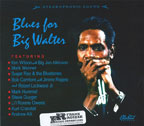 Various
artists
Various
artists
Blues for Big Walter
Eller Soul 2016
Although not as widely known or lauded as his contemporaries Little Walter
Jacobs and Sonny Boy Williamson II (Rice Miller), Big Walter Horton (1917-1981)
was one of the most adept and admired harmonica players in 20th century
blues.
Proficient on the “Mississippi saxophone” (he was Mississippi-born)
and arguably its innovator as an electrified instrument, he was one of
Muddy Waters’ myriad outstanding harmonica sidemen. The list of
blues legends whom he accompanied is awesome: Robert Johnson, Johnny Shines,
Honeyboy Edwards, Homesick James, B.B. King, Koko Taylor, Big Mama Thornton,
Robert Nighthawk, and John Lee Hooker (a partial list!).
So, a tribute album is warranted, and overdue. Kudos to harpman and producer
L’il Ronnie Owens for overseeing this project, with proceeds going
to the Blues Foundation and Hart Fund non-profit organizations.
Big Walter was revered for his full tone, idiosyncratic but smooth phrasing,
and unpretentious but memorable solos. Frustratingly, the paucity of liner
notes for this CD fails to clarify the rationale for song and artist selection.
Were these tunes favorites of Big Walter? Did he record versions of them?
Do they reflect his particular style? Did he mentor any of these players
(as he did Carey Bell)? We’re left in the dark. (In addition, there
aren’t even composition credits for any of the tunes, and sloppy
editing led to misspellings and omissions.)
However, the good news is that there is valuable music here, and a lot
of it: 76 minutes of it, to be exact. The lineup of harmonica mavens is
impressive. Kim Wilson, in his only appearance, leads off on “Someday,”
backing a solid performance by Big Jon Atkinson on guitar and vocal. “She
Loves Another Man” follows, recorded in 1992 and featuring Bob Corritore
on harp and the great Jimmy Rogers on guitar. (It is little known that
Rogers himself was an excellent harmonica player before he switched to
guitar in the classic 1950s Muddy Waters band, eclipsed on harmonica by
Little Walter.) Corritore appears again in a 2001 recording of “Rambling
on My Mind,” featuring Robert Lockwood Jr. on guitar and vocal.
Mark Wenner of The Nighthawks, Steve Guyger, Mark Hummel, and L’il
Ronnie each garner two tracks to shine on harmonica, as does Andrew Alli
on another two and Kurt Crandall on one; the latter two harpmen were unknown
to me, but distinguish themselves on three of the six instrumental tracks.
The centerpiece of the collection is “Sugar Ray Medley,” an
almost 19 minute number featuring Sugar Ray Norcia and his Bluetones bandmates
Anthony Geraci on piano, Mike Welch on guitar, Neil Gouvin on drums, and
Mudcat Ward on bass. A real tour de force, this track features changes
of tempo, lots of virtuoso harmonica, and even a brief midstream digression
to the tune “Blueberry Hill.”
Unlike many tribute albums, this one is less likely to provoke one to
revisit Big Walter’s oeuvre than to check out the work of the harpmen
featured here. That’s OK; they deserve recognition. —Steve
Daniels
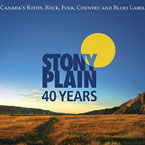 Various
Artists
Various
Artists
40 Years of Stony Plain
Stony Plain 3-CD
www.stonyplainrecords.com
As Canada’s Stony Plain founder/president Holger Petersen relates:
“Putting together this specially priced, 47 track, three CD set
has been a joy—not only going back over those years and selecting
some of our favorite tracks, but also digging deeper to find rare and
previously unreleased material (comprising the third CD) by old friends
Eric Bibb, Duke Robillard, Maria Muldaur, David Wilcox, the late Bob Carpenter,
Walter “Shakey” Horton and the legendary Sam Chatmon and His
Barbeque Boys from 1979.” Tellingly, the pair of Chatmon selections
(“I Hate That Train” and “All Night Long”) also
feature Colin Linden and Doc MacLean while Horton’s project-closing
track “Shakey’s Edmonton Blues,” reflects on the label’s
inauspicious origins—at the kitchen table of a suburban Edmonton,
Alberta house. The first disc is devoted, basically, to singers and songwriters
the likes of Doug Sahm. Emmylou Harris, Rodney Crowell, Ian Tyson, Steve
Earle and closes with Eric Bibb’s epic “Needed Time,”
that is musically fortified by Taj Mahal, The Blind Boys of Alabama and
Ruthie Foster. Disc two focuses on the label’s rootsy blues, gospel,
swing and jazz genres with the likes of Billy Boy Arnold, Long John Baldry,
Rosco Gordon, Jay McShann, Rory Block and Amos Garrett dropping by. Also
noted is Sonny Rhodes’ great invite to “Meet Me At The 10th
Street Inn” and Joe Louis Walker’s jauntily descriptive romper
“Eyes Like A Cat.” The intrepid Petersen has more than proved
it’s possible to prosper in an ever-wintry climate and at a distance
from the Toronto-centric, falderal-filled Canadian music scene. “It’s
too late to stop now,” as John Lee Hooker used to say. Worth twice
the price!—Gary von Tersch
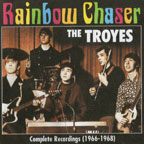 The Troyes
The Troyes
Rainbow Chaser
Cicadelic CD 72014 www.cicadelic.com
The inexplicably named Troyes were a short-lived, Battle Creek, Michigan-based
garage band that was quite active locally in the mid-sixties, led by lead
vocalist, songwriter and farfisa organist Lee Koteles along with four
of his high school buddies. Performing an enervating mix of covers and
originals at local teen hangouts and dance halls like Eddy’s and
Teens Inc. they were soon signed to bandleader Ray Anthony’s just
launched rock label, Space Records (a Capitol Records subsidiary), and
scored a regional smash right out of the box with their rousing “Rainbow
Chaser,” that rose to number three on the Top 40 in September of
1966—just ahead of the Four Tops with “Reach Out, I’ll
Be There” and the Supremes with “You Can’t Hurry Love.”
Anthony (of Peter Gunn and Dragnet-theme fame) had big plans for the combo
and insisted they record enough material for an album—nearly two
deck’s worth were recorded at Detroit’s United Sound studios
in late 1966 and early 1967. But, unluckily, only two singles were ever
issued, with the remainder in limbo. This 24 track compilation contains
them all—including three versions of “Rainbow” and two
of its also catchy flip side, the moody ballad “Why.” The
rest of the hook-laden efforts range from way-out psychedelia to totally
manic fuzz and farfisa garage to irascibly haunting sonancy. Favorites,
mostly in a downbeat romantic, Seeds-ian vein, encompass the likes of
“Someday You’ll See My Side,” “I Know Different,”
both sides of that second Space single (“Love Comes, Love Dies”
and “Help Me Find Myself”) and the band’s final recording,
an arresting commentary on their hometown, Battle Creek, where the Kellogg’s
cereal corporation was headquartered. An enclosed booklet of rare photos,
newspaper articles and Troyes ephemera rounds things out nicely. Well
worth tracking down.—Gary von Tersch
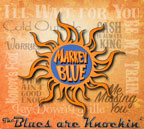 Markey
Blue
Markey
Blue
The Blues Are Knockin’
Soul Sound Records markeyblue.com
The band Markey Blue was formed in Nashville when Ric Latina and Jeanette
Markey teamed up as a duo for “a few club dates” and things
began to click. Together they started writing songs and found their diverse
backgrounds, Markey a Vegas showgirl, stand up comic and actress, while
Latina’s impressive resume of studio and touring work for some of
the top country stars out of Nashville, meant they weren’t your
typical blues band. They’ve gone all-out, assembling the best musicians
they could find but keeping the songwriting and production in their own
pocket. The results show in their second CD, “The Blues Are Knockin’”
that they are ready to answer the call.
Cutting through the ringing tambourine, delta Dobro and driving rhythm,
Markey’s husky voice cries out “I’ll Wait For You”
and picking up the pace, Lantina’s guitar takes the lead as Markey,
her voice taking on the tone like Shawn Murphy, declares “That Ain’t
Good Enough.” With a force like Etta James “Damn Your Eyes”
the undercurrent of the B3, blare of horns and chilling guitar solo heats
things up as Markey pleads it’s “Cold Outside.” Banking
on a solid rhythm and B3, Markey tells it like it is declaring “Cash
Is Always King” and the guitar pays out with interest. There’s
no escaping when “The Blues Are Knockin’” with its slow
wail of the guitar as Miss Blue’s sweet vocals take hold. “Be
My Train” lets Latini’s playing pay tribute to Little Milton
while Markey’s vocal on “Lay Down Lucille” with Ric’s
licks make this a full-on B.B. King tribute. Showing the full power of
Markey’s vocals, the message is tough and hard hitting, there’s
no doubt this girl is “Nobody’s Fool.” With the fluid
guitar lines against a quietly intense vocal, there is a heartfelt passion
on “Me Missing You.” As the guitar wails, Ric returns to the
licks of B.B. King for “Worries” as Markey lets her heart
take the lead.
With this second set of soulful sounds from the Markey Blue band once
you hear “The Blues Are Knockin’” open up that door
and let the blues begin.—Roger & Margaret White
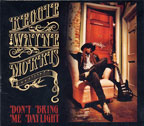 Reggie
Wayne Morris
Reggie
Wayne Morris
Don’t Bring Me Daylight
Blue Jay Sound rwmband.com
While not a second or third generation blues man, Reggie Wayne Morris
was raised by his extended family on a farm in Charlottesville, Virginia
where Gospel and blues was just part of life. At first the guitar was
something that preoccupied young Reggie but moving to Baltimore, Maryland
the occupation of bluesman found him. With his third release Morris has
broken out of the shadows with a slice of southern soul and blues called
“Don’t Bring Me Daylight,” co-written and co-produced
by Gerald “Gypsy” Robinson. With a rotating crew of blues
brothers Reggie’s band includes Chuck Fuerte or Ezell Jones on drums,
Vinny Hunter, Pete Kanaras, Chris Sellman or Ray Tilkens playing bass
with Mark Stevens or Bob Borderman on keyboards. On this offering they
lay out ten originals and a cover.
Leading with a ringing, lonesome-toned guitar, the “Son Of A Blues
Fan” is something many of our readers and musicians may relate to
and where better to hear all the best bands when you’re young then
right at home with gramp’s showing you the chords? His strat cries
as Reggie laments a woman that would come slipping in and he’d hope
she “Don’t Bring Me Daylight” when she comes home but
the saddest part is that he “Used To Have A Woman.” The piano
comes crashing in as he wonders why did he open up “Another Can
Of Worms” that might crash and burn again. The only cover is Ceophus
Palmer’s “Sign My Check,” the guitar’s lyrical
voice sings along with this sorrowful soul who finds himself dragging
that “Ball & Chain” which reminds me of Little Willie
John’s “I Need Your Love So Bad.” The steady snap of
the drum against the gentle ring of guitar similar to “Ain’t
Nobody’s Business If I Do,” Reggie’s voice pleading
“Meet Me” when I get home as the tension builds only to find
that “She’s Gone” as the guitar goes cutting through
that empty place. Many try to fill that space with sex and drugs and alcohol
as a mournful “OOOOO WEEEE” is all that comes but the reggae-like
ballad lifts him to be happy because “God Loves You.”
The songs of Reggie Wayne Morris’ new recording “Don’t
Bring Me Daylight” may seem like a heavy load if you listen to the
lyrics but the real power of the blues is the music; it can make everything
better.—Roger & Margaret White
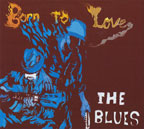 Dan
Treanor’s Afrosippi Band with Erica Brown & MJ
Dan
Treanor’s Afrosippi Band with Erica Brown & MJ
Born to Love the Blues
Plan-It Records 2015
How often do you encounter a blues album whose liner notes sort each song
into its blues sub-genre? Well, here we have one, its dozen cuts ranging
from “Memphis style boogaloo” to “a little Latin with
a Macon groove” to “neo soul.” Fortunately, the quality
matches the variety.
Dan Treanor, born and based in Colorado, is a veritable blues renaissance
man: guitarist, harmonica player, songwriter, producer, bandleader, African
instrument maker. He is winner of the Blues Foundation’s Keeping
the Blues Alive 2012 award as educator in schools, and his Afrosippi Band
placed third in the 2013 International Blues Challenge.
This follow-up to 2013’s “Tangled Road Again” once more
features Treanor on mouth harp (and occasionally guitar), with Michael
Hossler on lead guitar and powerhouse vocalists Erica Brown and Merrian
Johnson (MJ). Jack Erwin has assumed the bass duties, acquitting himself
admirably, and the drum kit has been taken over by Scott Headley, who
keeps for the most part to an unobtrusive steady bottom, but gooses the
proceedings on several tunes with some dazzling stickwork.
Four tracks are covers, including the Black Keys’ “Hurt Like
Mine,” labeled a “rockin’ blues” but more swingin’
than rockin’. The appropriately labeled “classic soul”
cover is Sam Cooke’s “A Change Is Going to Come,” addressed
by a soulful MJ vocal accompanied by Treanor’s fluid warbling harmonica
and Hossler’s lyrical guitar. Chicago blues is represented by “Knocked
Out,” distinguished by Brown’s pipes and Treanor’s harp.
The longest track, “Missing,” supposedly represents “the
Afrosippi sound,” although it actually resembles its predecessor
track, “Mississippi Fred’s Dream.” The latter is obviously
an homage to Mississippi Fred McDowell, the 20th century hill country
blues titan (who famously declared, “I don’t play no rock-and-roll,”
an assertion stressed in the lyrics). This “straight and natural
blues” number accurately reflects hill country blues’ emphasis
on rhythm and repetition rather than melody.
My favorite track, “A House Is Not a Home,” is a rocker, sporting
more excellent Hossler guitar work and terrific rhythm section interplay.
Despite some intermittently mannered singing by both Brown and MJ, “Born
to Love the Blues” is a worthy release by this tight ensemble.—Steve
Daniels
BOOK
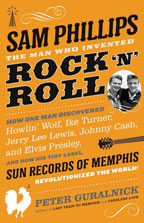 Sam
Phillips: The Man Who Invented Rock ‘N’ Roll
Sam
Phillips: The Man Who Invented Rock ‘N’ Roll
By Peter Guralnick
Little Brown & Company
$32 Hardcover
Sun Records, based in Memphis, Tennessee, was formed in 1952 by the extroverted
genius Sam Phillips, a former radio announcer who had opened the first
permanent recording studio in the long-time musical hotbed in 1950 to
record the abundance of local blues, rhythm ‘n’ blues and
country & western artists. For nearly two years Phillips leased commercially
successful sides to indie labels such as Modern and Chess, with his recordings
of the likes of Howlin’ Wolf, B.B.King, Harmonica Frank, Jackie
Brenston (of “Rocket 88” fame) and many others while unwittingly
providing the blueprint for the shortly ensuing yet equally raw R&B
sounds of Junior Parker & his Blue Flames, Ike Turner and Rufus Thomas
and many of their contemporaries—which, in roundabout fashion, then
provided the spark and rock (so to speak)-solid foundation for the just-around-the-corner,
mid-fifties genuine rock ‘n’ roll rhythms of Elvis Presley,
Carl Perkins, Roy Orbison, Johnny Cash and Jerry Lee Lewis. Over the course
of more than 700 pages, the easy-reading Guralnick calls upon not only
his quarter-century acquaintance (and abundance of interviews) with the
enterprising Phillips as well as capacious reflections by all of the above
musicians along with a host of others to, in essence, dramatically relate
the multi-faceted saga of the unleashing of rock ‘n’ roll—the
Big Beat!—upon the world. Back when jukeboxes, drive-ins and Top
40 radio stations ruled. Things don’t end well regarding Phillips,
but that’s often the case with multi-tasking visionaries (Phillips
also owned and “programmed” a variety of radio stations) and,
by the early seventies, the Sun label had set. But for those of a certain
age, such as yours truly, the magic of those early days remains as vivid
and aurally arresting as ever. Led Zepellin and Alice Cooper be damned!—Gary
von Tersch
Home
/ Blues Blogs /
Artist Links / Blues
Links / Videos / Store
Subscribe / Advertise
/ Back Issues
/ Contact / Staff